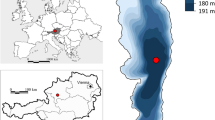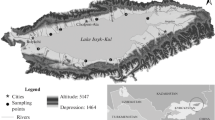Abstract
Lake Hallstättersee is a holomictic alpine lake, which is influenced by salt mining since the middle Bronze Age. Beside the constant saline waste water load, two massive brine spills loaded the lake with additional 16,900 tons sodium chloride (≈10,250 tons Cl−) from 1977 to 1979 and 3,000 tons salt (≈1,820 tons Cl−) in 2005. The effect of waste water intrusions from salt mining on stratification of Lake Hallstättersee was analysed over a period of 40 years. Water density, dissolved oxygen and total phosphorus (TP) concentrations were measured and an exponential model was fitted to describe the wash-out of chloride from Lake Hallstättersee after the brine spills. Furthermore, the time required returning to holomixis and steady chloride content after the second brine spill was estimated. During the whole sampling period the minimum and maximum volume-weighted annual mean chloride concentrations were 23.58 mg/L in 1979 and 3.19 mg/L in 1998. However, the mixing regime of Lake Hallstättersee, as well as the chloride concentrations, varied considerably and exhibited three holomictic and three meromictic periods between 1970 and 2009. Holomictic periods were observed when the yearly density gradient was below 0.06 kg/m3, deepwater oxygen in spring above 4 mg/L and consequently declining TP concentration in the deepest water layer below 60 mg/m3, otherwise meromictic periods were observed. Our study showed that Hallstättersee was 13 years ectogenic meromictic and 27 years holomictic during the study period.







Similar content being viewed by others
References
Androsch, H. (2008). Salz—die weiße Seele einer Landschaft. In L. Maurer et al. (Eds.), Reisen durch Oberösterreich, Band II (pp. 44–55). Linz: Trauner Verlag.
Bäthe, J., Herbst, V., Hofmann, G., Matthes, U., & Thiel, R. (1994). Folgen der Reduktion der Salzbelastung in Werra und Weser für das Fließgewässer als Ökosystem. Wasserwirtschaft, 84, 528–536.
Bäuerle, E., Ollinger, D., & Ilmberger, J. (1998). Some meterological, hydrological and hydrodynamical aspects of Upper Lake Constance. Archives Hydrobiologica Special Issues on Advanced Limnology, 53, 31–83.
Bührer, H., & Ambühl, H. (1975). Die Einleitung von gereinigtem Abwasser in Seen. Schweizerische Zeitschrift für Hydrologie, 37, 347–368.
Ebina, J., Tsutsui, T., & Shirai, T. (1983). Simultaneous determination of total nitrogen and total phosphorus in water using peroxodisulfate oxidation. Water Research, 17(12), 1721–1726.
Effler, S. W., & Driscoll, C. T. (1986). A chloride budget for Onondaga Lake, New York USA. Water, Air and Soil Pollution, 27, 29–44.
Gaisbauer, E. (1998). Einführungsvortrag zur Exkursion zum Salzbergbau Altaussee der SALINEN AUSTRIA GmbH. Bergbautechnik und Sicherheit, Heft 11. Jahrestagung 1998 der Sticherheitsbeauftragten des österreichischen Bergbaus, Bad Aussee.
Gassner, H., & Achleitner, D. (2007). Die Auswirkungen der Einleitung von Sole aus dem Salzbergbau Hallstatt (Salinen Austria AG) auf den limnologischen Zustand und das Makrozoobenthos des Hallstättersees. Bundesamt für Wasserwirtschaft, Institut für Gewässerökologie, Fischereibiologie und Seenkunde; Scharfling, Mondsee (not published).
Gassner, H., Jagsch, A., Zick, D., Bruschek, G., Frey, I., Mayrhofer, K. (2006). Die Wassergüte ausgewählter Seen des oberösterreichischen und steirischen Salzkammergutes 2001–2005, Band 24. Schriftenreihe des BAW, Wien, Austria.
Hakala, A. (2004). Meromixis as a part of lake evolution-observations and a revised classification of true meromictic lakes in finland. Boreal Enviroment Research, 9, 37–53.
Hart, B. T., Bailey, P., Edwards, R., Hortle, K., James, K., McMahon, A., et al. (1991). A review of the salt sensitivity of the Australian freshwater biota. Hydrobiologia, 210, 105–144.
Hattinger, G. (2004). Johann Georg Ramsauer als Bergmeister am Hallstätter Salzberg (1831–1863). Jahrbuch der geologischen Bundesanstalt, Band 144. Heft 1, Wien, Austria. pp. 77–87.
Hefler, F. (2002). Gesetzliche Begrenzung von Abwasseremissionen aus der Aufbereitung, Veredelung und Weiterverarbeitung von Steinsalz und allen anderen mit diesen vorkommenden Salzen. AEV Salzherstellung, BGBL. II Nr. 43/2002.
Hutchinson, E. (1957). A Treatise on Limnology, Volume I. New York: Chapman & Hall.
Jackson, R. B., & Jobbágy, E. G. (2005). From icy roads to salty streams. Proceedings of the National Academy of Sciences of the United States of America, 102(41), 14487–14488.
Jagsch, A. (1982). Limnologische Untersuchung Traunsee—Traun, Bericht Nr. 7—Hallstättersee und Mondsee. Amt der oberösterreichischen Landesregierung, Linz.
Jagsch, A., Gassner, H., & Dokulil, M. T. (2002). Long-term changes in environmental variables of Traunsee, an oligotrophic Austrian lake impacted by the salt industry, and two reference sites, Hallstättersee and Attersee. Water, Air, & Soil Pollution: Focus, 2, 9–20.
Karakas, G., Brookland, I., & Boehrer, B. (2003). Physical characteristics of Acidic Mining Lake 111. Aquatic Sciences, 65, 297–307.
Kaushal, S. S., Groffman, P. M., Likens, G. E., Belt, K. T., Stack, W. P., Kelly, V. R., et al. (2005). Increased salinization of fresh water in the northeastern United States. Proceedings of the National Academy of Sciences of the United States of America, 102(38), 13517–13520.
Kelly, V. R., Lovett, G. M., Weathers, K. C., Findlay, E. G., Strayer, D. L., Burns, D. J., et al. (2008). Long-term sodium chloride retention in a rural watershed: legacy effects of road salt on streamwater concentration. Environmental Science & Technology, 42, 410–415.
Langen, T. (2007). Long-Term Consequences of Winter Road management Practices to Water Quality at High-Altitude lakes Within the Adirondack State Park (New York State). In: Proceedings of the 2007 International Conference on Ecology and Transportation, edited by C. Leroy Irwin, Debra Nelson, and K.P. McDermott. Raleigh, NC: Center for Transportation and the Environment, North Carolina State University. p. 613.
Löffler, H. (1983a). Aspects of the history and evolution of Alpine lakes in Austria. Hydrobiologia, 100, 143–152.
Löffler, H. (1983b). Changes of the benthic fauna of the profundal zone of Traunsee (Austria) due to salt mining activities. Hydrobiologia, 103(1), 135–139.
Morton, F. (1940). Thermik und Sauerstoffverteilung im Hallstätter See. A. Die Thermik des Hallstätter Sees. Archiv für Hydrobiologie, Bd. XXXVII. pp. 155–162.
Morton, F. (1953). Hallstatt: ein Gang durch die Sammlungen des Hallstätter Museums mit einem Rückblick auf die viertausendjährige Kultur des berühmten Bergmannsortes. Musealvereines Hallstatt, Hallstatt: Verl. d.
Pechlaner, R., & Sossau, C. (1982). Die Ergebnisse der fünfjährigen Studie „Limnologische Untersuchung Traunsee-Traun, Bericht Nr. 13. Amt der oberösterreichischen Landesregierung, Linz.
Pittino, G., & Golser, J. (2004). Creep behaviour of Alpine Salt Rock and the influence of insoluble residues in solution mining. In R. Hack, R. Azzam, & R. Charlier (Eds.), LNES 104, Engineering Geology for Infrastructure Planning in Europe (pp. 593–603). Berlin: Springer.
Rachael, E., & Halfman, J.D. (2007). Decreasing salinity in Seneca Lake, New York. Geological Society of America, Annual Meeting, Denver, 28–31 October 2007.
Rimmer, A., Yasuaki, A., Kumagai, M., & Eckert, W. (2005). Chemical stratification in thermally stratified lakes: a chloride mass balance model. Limnology and Oceanography, 50(1), 147–157.
Ruttner, F. (1937). Limnologische Studien an einigen Seen der Ostalpen. Archives of Hydrobiology, 32, 167–319.
Scharf, B. W., & Oehms, M. (1992). Physical and chemical characteristics. Archives of Hydrobiology Beih, 38, 63–83.
Schönborn, W. (1992). Fließgewässerbiologie. Jena: Gustav-Fischer Verlag.
Urstöger, H. J. (2000). Hallstatt-Chronik: von den Anfängen bis zum Jahr 2000. Hallstatt: Verl. d. Musealvereins Hallstatt.
Varekamp, J. C. (2002). Lake contamination models for evolution towards steady state. Papers from Bolsena Conference, Residence time in lakes: Science, Management, Education. Journal of Limnology, 62(Suppl. 1), 67–72.
Ziemann, H. (1971). Die Wirkung des Salzgehaltes auf die Diatomeenflora als Grundlage für eine biologische Analyse und Klassifikation der Binnengewässer. Limnologica, 8(2), 505–525.
Acknowledgements
Thanks to the laboratory and sampling team of the Federal Agency for Water Management, Institute for Freshwater Ecology, Fisheries Management and Lake Research in Scharfling, Mondsee for collecting the data and furthermore to the SALINE Austria AG for providing additional information about the salt production.
Author information
Authors and Affiliations
Corresponding author
Rights and permissions
About this article
Cite this article
Ficker, H., Gassner, H., Achleitner, D. et al. Ectogenic Meromixis of Lake Hallstättersee, Austria Induced by Waste Water Intrusions from Salt Mining. Water Air Soil Pollut 218, 109–120 (2011). https://doi.org/10.1007/s11270-010-0627-2
Received:
Accepted:
Published:
Issue Date:
DOI: https://doi.org/10.1007/s11270-010-0627-2




